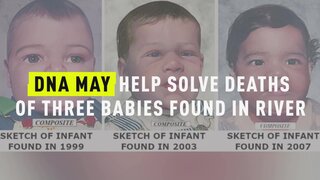Create a free profile to get unlimited access to exclusive videos, breaking news, sweepstakes, and more!
Genetic Genealogy May Be Key To Solving The Deaths Of Three Babies Found In A River
Three infants found dead in a river in Goodhue County, Minnesota between 1999 and 2007 were thought to born alive.

Genetic Genealogy may be the key to unlocking the mystery of how and why three infants were found dead in a Minnesota river on three separate occasions over the course of a decade.
The unidentified infants were found in the Mississippi River of Goodhue County, Minnesota between 1999 and 2007, St. Paul’s Pioneer Press reports.
In August of 2020, the Goodhue County Sheriff’s Office publicly appealed for financial contributions to help pay for the genealogical investigations for two of the three cases. They announced that they’d teamed up with Virginia-based Parabon Snapshot DNA, which would conduct genetic genealogy analysis reports.
The Sheriff’s Office would pay themselves for the first of the three babies discovered.
On Nov. 4, 1999, a fisherman in Red Wing discovered a Caucasian baby girl near Bay Point Park. She was wrapped in a towel and believed to be one to two weeks old.
Police said she’d been in the water for some time, based on the advanced stage of decomposition.
Fours years later and 20 miles away, four teenagers came upon the body of a newborn male along the shores of Lake Pepin near Frontenac. Investigators say the boy was between four and five days old.
Less sophisticated DNA testing led authorities to believe that the first two infants were maternally related, the sheriff's office fundraiser stated.
On March 26, 2007, two employees for the Treasure Island Resort and Casino found another newborn girl at a boat slip. The girl is thought to be Indigenous American or Hispanic.
Investigators could not determine whether the baby was dead or alive when she was put in the water.
But now, the technology provided by genetic genealogy, which uses DNA profiling and testing to identify family members through databases, is helping law enforcement move forward in the ongoing investigation.
“We did get some leads that (the department) has been following up on,” said retired Goodhue County investigator Glen Barringer, according to the Pioneer Press. “It kind of goes from one lead to another. It’s very time-consuming for (the lead investigator) when he has a chance to work on it. But for the ’99 case, we did get some names.”
Goodhue County Sheriff’s Office investigator Jon Huneke now heads the investigation.
“We are miles ahead, but we have miles to go,” said Barringer. “We’re at 50 to 70 percent chance (of solving them). Before we were at 10 percent.”
Genetic genealogy is growing into a standard scientific technique aiding law enforcement around the country in solving cold cases which include The Golden State Killer, The BTK Killer, and The Grim Sleeper.
Barringer, who retired only one month after submitting the blood samples to Parabon discussed the difficulty of working this case.
“We had a family who donated three grave sites for these babies,” Barringer continued. “All cops have cases that haunt them.”
The case of the three unidentified infants remains open.






















